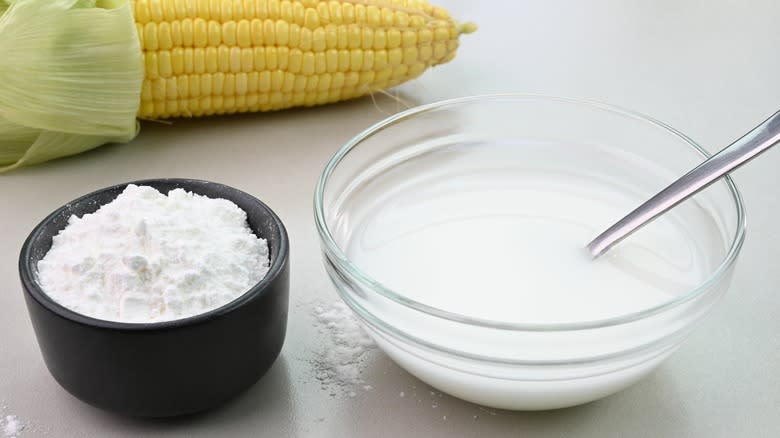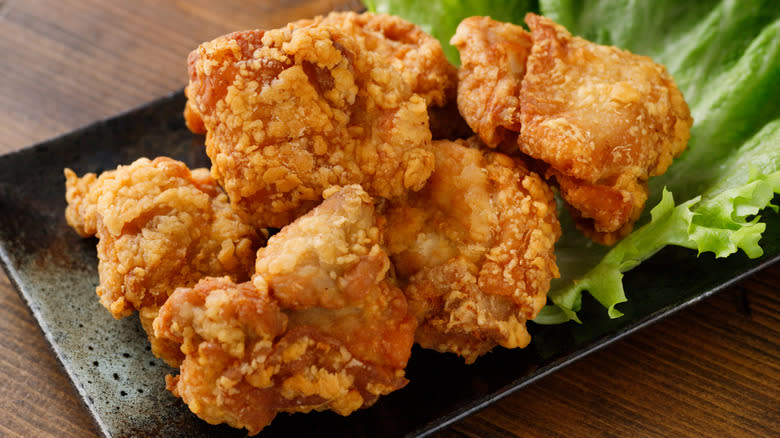The Key To Crispy Dumplings Is A Little Cornstarch

If you are a fan of the stuffed Polish dumplings known as pierogi or enjoy Japanese gyoza or Chinese guo tie, then a big reason for that -- beyond the delectable filling and slightly chewy casings -- is probably their golden, crisp-fried bottoms. Those distinct bottoms provide a lightly caramelized flavor, needed structure, and the perfect textural complement to little pan-fried, boiled, or steamed packages of delicious stuffings. If, like many people, you're really into that crispy bottom crust, we have a technique for you to try the next time you want to bust out your favorite frozen potstickers: Dust them in cornstarch before cooking.
But wait -- isn't cornstarch typically used as a thickening agent? Why would you use a thickening agent on dumplings? Because cornstarch, a key ingredient in soft, fluffy baked goods, does more than gelatinize through water absorption; it also fries to a flawless, golden, lacy crisp. Although many dumpling wrappers contain wheat starch, which causes dumplings to turn golden when fried -- a dusting of cornstarch will boost the crispiness in the crust.
Read more: 10 Frozen Foods You Should Always Buy At Aldi
The Science Of Starchy-Crisp Deliciouness

It doesn't matter which of the many kinds of dumplings you crave, or even how you cook them, be it boiling or steaming. The bottoms should be dusted and pan-fried just before eating, essentially as a finishing move. This goes for dumplings made from scratch and the premade kind you can pick up in your grocery store's frozen foods section. What this means, of course, is that you're essentially creating a second cooking process -- not to make the filling or casing edible, but to perfect the crust. Here's where the starch comes in.
Once your dumplings are cooked through, take them out of the pot or steamer and drain off any excess water. It's not necessary to completely dry the dumplings as you would if you were deep-frying them. The cornstarch will absorb excess water, which will then convert to steam, allowing the bottoms to form that crisp crust. After the dumplings have drained, place them, bottom-side down, on a plate covered with cornstarch. Then, into a hot skillet coated with enough oil to fry up a solid crust.
Asian Cooks Figured This Out A Long Time Ago

If you want to go crazy, fully dredge the raw dumplings in cornstarch and use a hybrid cooking technique. First, brown their bottoms in a wok or skillet with a small amount of hot oil. Once the bottoms are browned, add water and immediately cover the pan. The resulting steam will create a starchy slurry which will coat the bottom of the pan, eventually creating a crisp-fried, lacy crust coating the bottom of the pan as the water steams away and the starch slurry fries. This method can be a little tricky timing-wise but can be mastered with a little practice.
When it comes to getting that crispy bottom on your dumplings and potstickers, you don't have to go with only cornstarch -- potato starch also works in this application. Both are gluten-free and odorless; cornstarch might have a very slight sweetness, but it's unnoticeable in this type of use. Cornstarch can be used to crisp up almost anything that's pan- or even deep-fried: Unlike their counterparts in the American South, Japanese cooks don't dredge their chicken in flour; instead, they use potato starch to get super-crunchy batter-fried chicken. Potato starch, or katakuriko, absorbs hot oil as much as it does water, and the result is a crust that won't lose its crispiness as quickly as one made with wheat starch, used by many Americans in their breading.
Read the original article on Daily Meal.

 Yahoo Sports
Yahoo Sports 
